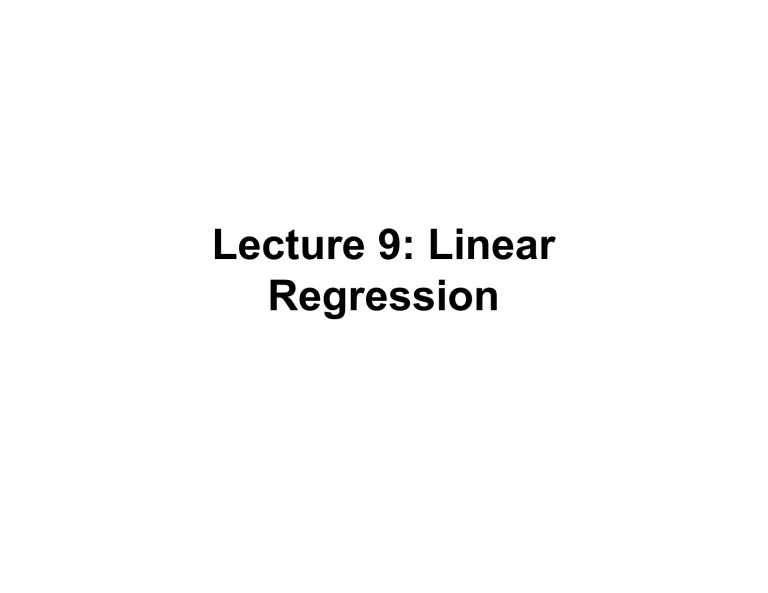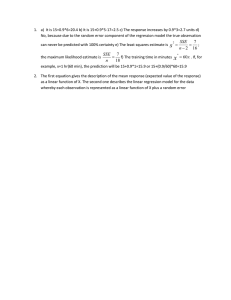
Lecture 9: Linear Regression Goals • Develop basic concepts of linear regression from a probabilistic framework • Estimating parameters and hypothesis testing with linear models • Linear regression in R Regression • Technique used for the modeling and analysis of numerical data • Exploits the relationship between two or more variables so that we can gain information about one of them through knowing values of the other • Regression can be used for prediction, estimation, hypothesis testing, and modeling causal relationships Regression Lingo Y = X1 + X2 + X3 Dependent Variable Independent Variable Outcome Variable Predictor Variable Response Variable Explanatory Variable Why Linear Regression? • Suppose we want to model the dependent variable Y in terms of three predictors, X1, X2, X3 Y = f(X1, X2, X3) • Typically will not have enough data to try and directly estimate f • Therefore, we usually have to assume that it has some restricted form, such as linear Y = X1 + X2 + X3 Linear Regression is a Probabilistic Model • Much of mathematics is devoted to studying variables that are deterministically related to one another y = " 0 + "1 x y ! "y "x "0 ! ! ! "1 = #y #x x ! ! • But we’re interested in understanding the relationship between variables related in a nondeterministic fashion ! A Linear Probabilistic Model • Definition: There exists parameters " 0 , "1, and " ,2 such that for any fixed value of the independent variable x, the dependent variable is related to x through the model equation !# y = "!0 +! "1 x + 2 • " is a rv assumed to be N(0, # ) True Regression Line ! "3 y "2 "1 ! "0 ! ! ! ! x ! y = " 0 + "1 x Implications • The expected value of Y is a linear function of X, but for fixed x, the variable Y differs from its expected value by a random amount • Formally, let x* denote a particular value of the independent variable x, then our linear probabilistic model says: E(Y | x*) = µY|x* = mean value of Y when x is x * 2 V (Y | x*) = " Y|x* = variance of Y when x is x * ! ! Graphical Interpretation y y = " 0 + "1 x µY |x 2 = " 0 + "1 x 2 ! ! ! µY |x1 = " 0 + "1 x1 ! x x2 x1 • For example, if x = height and y = weight then ! µ! Y |x =60 weight for! all individuals 60 inches tall in the population ! is the average One More Example Suppose the relationship between the independent variable height (x) and dependent variable weight (y) is described by a simple linear regression model with true regression line y = 7.5 + 0.5x and " = 3 • Q1: What is the interpretation of "1 = 0.5? The expected change in height associated with a 1-unit increase ! in weight ! • Q2: If x = 20 what is the expected value of Y? µY |x =20 = 7.5 + 0.5(20) = 17.5 • Q3: If x = 20 what is P(Y > 22)? ! " 22 -17.5 % P(Y > 22 | x = 20) = P$ ' = 1( ) (1.5) = 0.067 # 3 & Estimating Model Parameters • Point estimates of "ˆ 0 and "ˆ1 are obtained by the principle of least squares n f (" 0 , "1 ) = $ [ y i # (" 0 + "1 x i )] 2 ! ! i=1 y ! "0 x ! • ! "ˆ = y # "ˆ x 0 1 ! Predicted and Residual Values • Predicted, or fitted, values are values of y predicted by the leastsquares regression line obtained by plugging in x1,x2,…,xn into the estimated regression line yˆ1 = "ˆ 0 # "ˆ1 x1 yˆ = "ˆ # "ˆ x 2 0 1 2 • Residuals are ! the deviations of observed and predicted values e1 = y1 " yˆ1 e2 = y 2 " yˆ 2 ! y y1 ! yˆ1 ! ! ! ! e3 e2 e1 ! ! x Residuals Are Useful! • They allow us to calculate the error sum of squares (SSE): n n SSE = " (ei ) = " (y i # yˆ i ) 2 2 i=1 i=1 • Which in turn allows us to estimate " 2 : ! "ˆ 2 = SSE n #2 ! • As well as an important statistic referred to as the coefficient of ! determination: SSE 2 r = 1" SST ! ! n SST = # (y i " y ) 2 i=1 Multiple Linear Regression • Extension of the simple linear regression model to two or more independent variables y = " 0 + "1 x1 + " 2 x 2 + ...+ " n x n + # Expression = Baseline + Age + Tissue + Sex + Error ! • Partial Regression Coefficients: βi ≡ effect on the dependent variable when increasing the ith independent variable by 1 unit, holding all other predictors constant Categorical Independent Variables • Qualitative variables are easily incorporated in regression framework through dummy variables • Simple example: sex can be coded as 0/1 • What if my categorical variable contains three levels: xi = 0 if AA 1 if AG 2 if GG Categorical Independent Variables • Previous coding would result in colinearity • Solution is to set up a series of dummy variable. In general for k levels you need k-1 dummy variables x1 = 1 if AA 0 otherwise x2 = 1 if AG 0 otherwise x1 x2 AA 1 0 AG 0 1 GG 0 0 Hypothesis Testing: Model Utility Test (or Omnibus Test) • The first thing we want to know after fitting a model is whether any of the independent variables (X’s) are significantly related to the dependent variable (Y): H 0 : "1 = " 2 = ... = " k = 0 H A : At least one "1 # 0 R2 k f = • 2 (1$ R ) n $ (k + 1) Rejection Region : F" ,k,n#(k +1) ! ! Equivalent ANOVA Formulation of Omnibus Test • We can also frame this in our now familiar ANOVA framework - partition total variation into two components: SSE (unexplained variation) and SSR (variation explained by linear model) Equivalent ANOVA Formulation of Omnibus Test • We can also frame this in our now familiar ANOVA framework - partition total variation into two components: SSE (unexplained variation) and SSR (variation explained by linear model) Source of Variation df Sum of Squares MS F Regression k SSR = # ( yˆ i " y ) 2 MSR MSE Error n-2 SSE = # (y i " yˆ i ) 2 SSR k SSE n "2 Total ! n-1 ! ! ! SST = # (y i " y ) 2 ! Rejection Region : F" ,k,n#(k +1) ! F Test For Subsets of Independent Variables • A powerful tool in multiple regression analyses is the ability to compare two models • For instance say we want to compare: Full Model : y = " 0 + "1 x1 + " 2 x 2 + " 3 x 3 + " 4 x 4 + # Reduced Model : y = " 0 + "1 x1 + " 2 x 2 + # ! • Again, another example of ANOVA: ! SSER = error sum of squares for reduced model with l predictors SSEF = error sum of squares for full model with k predictors ! (SSE R " SSE F ) /(k " l) f = SSE F /([n " (k + 1)] Example of Model Comparison • We have a quantitative trait and want to test the effects at two markers, M1 and M2. Full Model: Trait = Mean + M1 + M2 + (M1*M2) + error Reduced Model: Trait = Mean + M1 + M2 + error (SSE R " SSE F ) /(3 " 2) (SSE R " SSE F ) f = = SSE F /([100 " (3 + 1)] SSE F /96 Rejection Region : Fa, 1, 96 ! Hypothesis Tests of Individual Regression Coefficients • Hypothesis tests for each "ˆ i can be done by simple t-tests: ! H 0 : "ˆ i = 0 H : "ˆ # 0 A i "ˆ i $ " i T= se(" i ) Critical value : t" / 2,n#(k#1) ! • Confidence Intervals are equally easy to obtain: ! "ˆ i ± t# / 2,n$(k$1) • se("ˆ i ) Checking Assumptions • Critically important to examine data and check assumptions underlying the regression model Outliers Normality Constant variance Independence among residuals • Standard diagnostic plots include: scatter plots of y versus xi (outliers) qq plot of residuals (normality) residuals versus fitted values (independence, constant variance) residuals versus xi (outliers, constant variance) • We’ll explore diagnostic plots in more detail in R Fixed -vs- Random Effects Models • In ANOVA and Regression analyses our independent variables can be treated as Fixed or Random • Fixed Effects: variables whose levels are either sampled exhaustively or are the only ones considered relevant to the experimenter • Random Effects: variables whose levels are randomly sampled from a large population of levels • Example from our recent AJHG paper: Expression = Baseline + Population + Individual + Error




